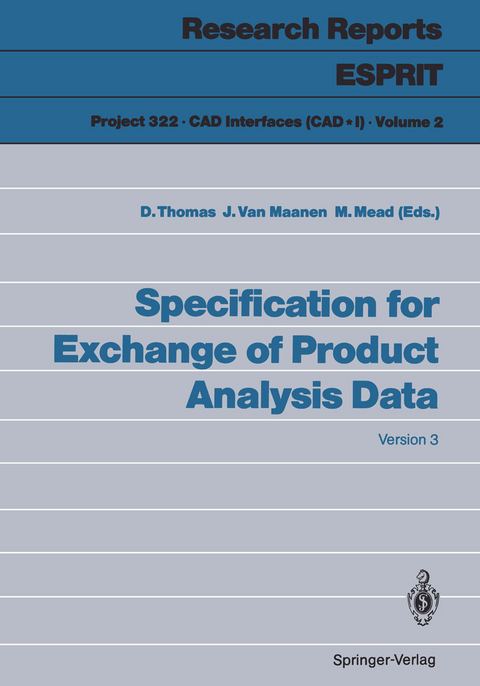
Specification for Exchange of Product Analysis Data
Version 3
Seiten
1989
|
1989
Springer Berlin (Verlag)
978-3-540-51579-1 (ISBN)
Springer Berlin (Verlag)
978-3-540-51579-1 (ISBN)
Edited for Working Group 6: Ges.f.Strukturanalyse, Aachen/ FRG; NEH Consulting Engineers ApS, Broendby/DK; Rutherford Appleton Lab., Chilton/UK; Estudios y Realizaciones en Diseno Informatizado SA, Madrid/Spain; Empresa Nacional deIngenieria y Tecnologia SA, Madrid/Spain
During the past 25 years computers have been introduced in industry to perform technical tasks such as drafting, design, process planning, data acquisition, process control, and quality assurance. Computerized solutions nevertheless have normally been single, isolated devices within a manufacturing plant. Computer technology is still evolving rapidly. The life cycle of todays' products and production methods is shortening, with continuously increasing requirements of customers, and a trend to market interrelations between companies at a national and international level. This urges a need for efficient storage retrieval and exchange of information. Integration of information flow is urgent inside companies to closely connect together departments, which used to work, more or less, on their own. On the other hand direct communication with outside customers, suppliers, and partner institutions will often determine the position of an enterprise among the competitors. In this sense, computer integrated manufacturing (CIM) is the key of today for the competitiveness of tomorrow. But the realisation of a future oriented CIM concept is not possible without powerful, widely accepted, and standardised interfaces. They are the vital issue on the way to CIM. They will contribute to harmonise data structures and information flows and play a major role for open CIM systems. Standardised interfaces should allow for: Access to data produced and archived on computing equipment which is no longer in active use; Communication between hardware and software from different vendors; Paperless exchange of information.
During the past 25 years computers have been introduced in industry to perform technical tasks such as drafting, design, process planning, data acquisition, process control, and quality assurance. Computerized solutions nevertheless have normally been single, isolated devices within a manufacturing plant. Computer technology is still evolving rapidly. The life cycle of todays' products and production methods is shortening, with continuously increasing requirements of customers, and a trend to market interrelations between companies at a national and international level. This urges a need for efficient storage retrieval and exchange of information. Integration of information flow is urgent inside companies to closely connect together departments, which used to work, more or less, on their own. On the other hand direct communication with outside customers, suppliers, and partner institutions will often determine the position of an enterprise among the competitors. In this sense, computer integrated manufacturing (CIM) is the key of today for the competitiveness of tomorrow. But the realisation of a future oriented CIM concept is not possible without powerful, widely accepted, and standardised interfaces. They are the vital issue on the way to CIM. They will contribute to harmonise data structures and information flows and play a major role for open CIM systems. Standardised interfaces should allow for: Access to data produced and archived on computing equipment which is no longer in active use; Communication between hardware and software from different vendors; Paperless exchange of information.
A. General Information.- A.1 Executive Summary.- A.2 Background Information.- A.3 Example Neutral File.- A.4 General File Structure.- A.5 External Envelope Concept.- B. Reference Section.- B.1 Syntax Definition.- B.2 Levels of the Neutral File.- B.3 Keywords for FE Model Description.- B.4 Keywords for the FE Analysis.- B.5 Keywords for FE Results.- B.6 Notes.- C. Implementation.- C.1 Processors for FE data.- C.2 Software Developed by the Partners.- D. Discussion of the CAD-FEM Data Transfer.- D.1 Introduction.- D.2 CAD/FEM Interchange Environment.- D.3 The CAD*I Approach to the CAD/FEM Interface.- D.4 Guidelines for FE Modelling.- D.5 Heuristic Rules for FE Modelling.- D.6 The FEM to CAD Interface.- D.7 Conclusions.- References.
| Erscheint lt. Verlag | 23.8.1989 |
|---|---|
| Reihe/Serie | Project 322. CAD Interfaces (CAD*1) | Research Reports Esprit |
| Zusatzinfo | XVI, 146 p. |
| Verlagsort | Berlin |
| Sprache | englisch |
| Maße | 170 x 242 mm |
| Gewicht | 310 g |
| Themenwelt | Informatik ► Weitere Themen ► CAD-Programme |
| Technik ► Maschinenbau | |
| Schlagworte | CAD-Schnittstelle • data structures • Datenaustausch • Finite-Elemente-Analysis • Modellierungssprachen • Neutrale Datei |
| ISBN-10 | 3-540-51579-8 / 3540515798 |
| ISBN-13 | 978-3-540-51579-1 / 9783540515791 |
| Zustand | Neuware |
| Haben Sie eine Frage zum Produkt? |
Mehr entdecken
aus dem Bereich
aus dem Bereich
Buch | Softcover (2023)
Beuth (Verlag)
99,00 €
Einführung in die Geometrische Produktspezifikation
Buch | Softcover (2023)
Europa-Lehrmittel (Verlag)
20,70 €


